How to Fill Empty Space in Living Room: Creative and Practical Ideas
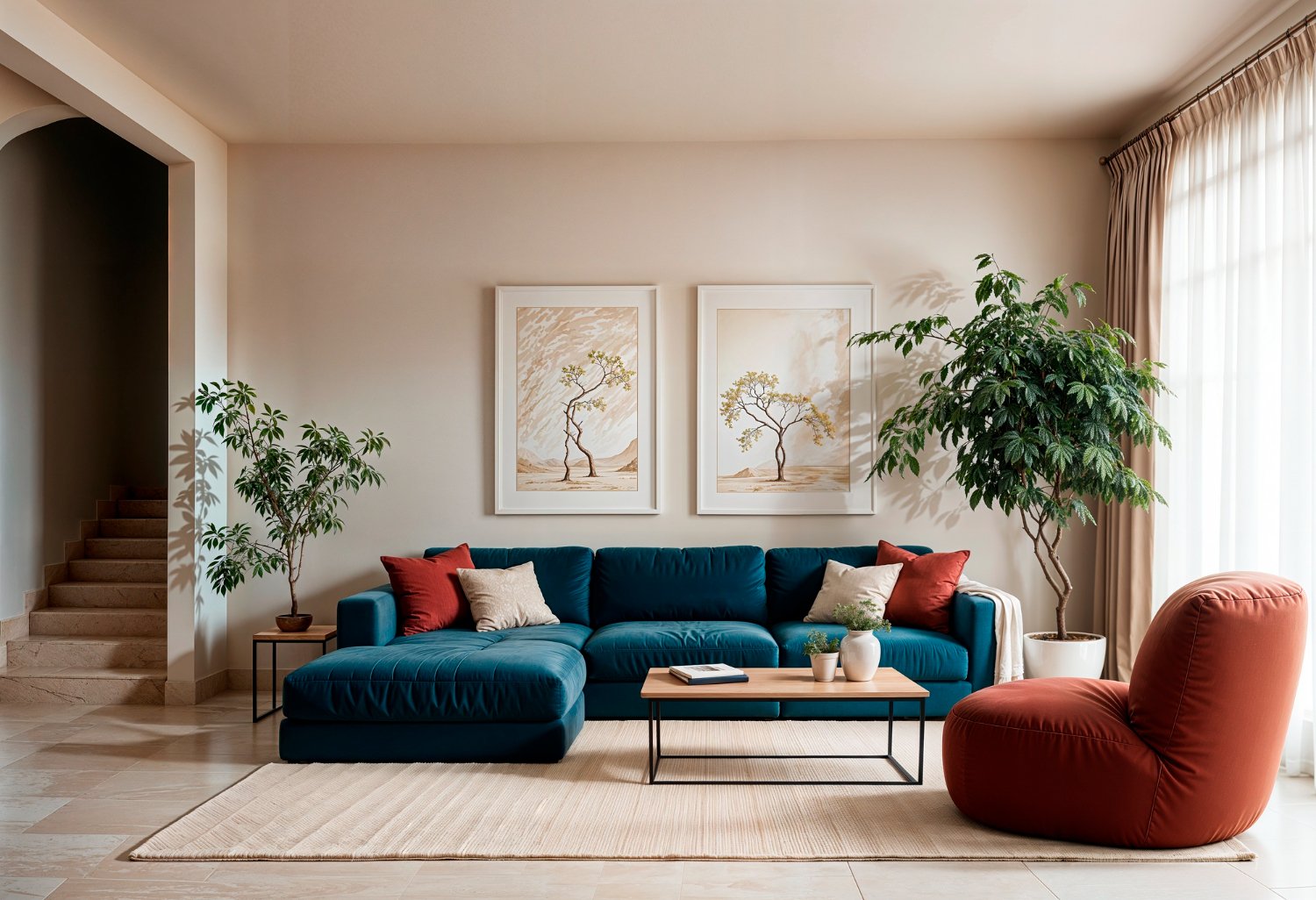
Empty space in a living room can make the room feel unfinished or cold.
The best way to fill this space is to combine functional furniture, thoughtful decor, and lighting that together create a warm and inviting atmosphere.
Small touches like plants, shelves, or cozy seating can turn empty corners into useful areas. You don’t have to overcrowd the room to make it feel lived-in.
I’ve found that noticing which parts of your living room feel empty helps you pick the right solution. Sometimes you need height—think tall lamps or plants—other times, it’s about creating little zones for relaxing or working.
These simple ideas can really change how your living room looks and feels. It’s all about making things feel more balanced and complete, even if you’re not sure where to start.
Exploring creative ways to use the empty space adds personality and purpose. Whether you’re setting up a reading nook, a gallery wall, or some clever storage, these options maximize both style and usability.
Filling your living room’s empty space doesn’t have to be hard. Once you spot the gaps, you’ll know how to act on them.
Key Takeaways
- Identify empty areas to choose the right furniture and decor.
- Use lighting and plants to add warmth and height.
- Combine style with function using cozy and creative solutions.
Assessing Your Living Room’s Empty Spaces
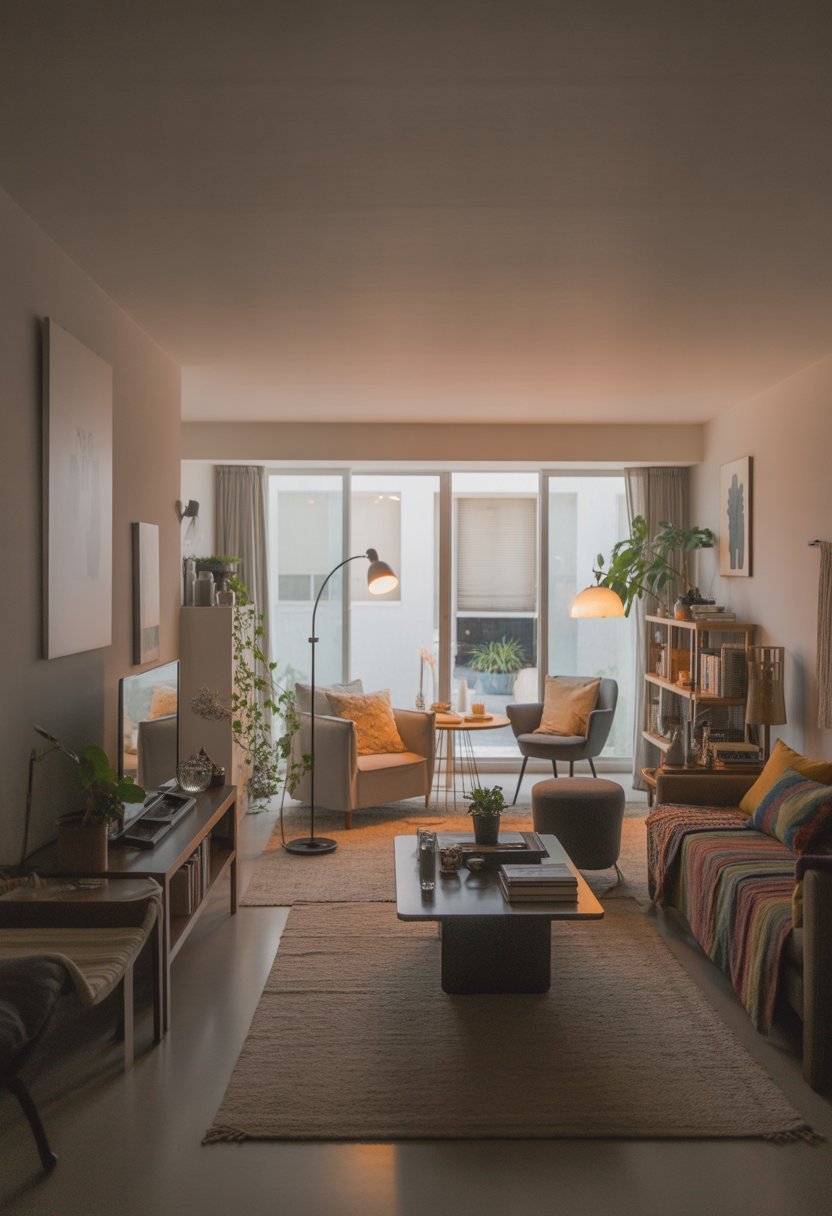
Before adding anything, I like to look closely at my living room’s layout. I pay attention to where the empty spaces are and how they affect movement.
I also think about what the room is mainly used for. This makes it easier to choose pieces that fit both the space and my daily needs.
Evaluating Room Layout and Flow
I walk through the room to see how easy it is to move around. A good living room layout keeps clear paths without furniture blocking the way.
If the furniture feels scattered or the flow is awkward, the empty spaces might be part of the problem. I check if the arrangement highlights a focal point, like a fireplace or TV.
Empty areas near the main seating or walls can help balance the design. This step shows me where added furniture or decor could improve the flow.
Identifying Awkward Corners and Large Open Areas
Empty living room corners often stand out because they break the visual balance. I look for spots that feel disconnected or just too bare.
These awkward corners can shrink the feel of the room or make it look unfinished. Large open areas sometimes seem too empty or cold, so I measure these spaces and think about how they relate to the rest of the room.
Breaking up big open floors with rugs or furniture groups helps the room feel more intentional. You don’t want space to feel wasted, right?
Considering Room Functionality
I ask myself what I use the living room for most. Is it for relaxing, entertaining, or maybe working?
Empty spaces should support those functions. For example, if I entertain a lot, I might turn an empty corner into extra seating or a bar cart spot.
If I need a quiet area, the empty space could become a reading nook or office corner. Focusing on function helps me fill the room without cluttering it or losing purpose.
For more ideas on filling empty spaces, check out How to Fill Empty Space and Awkward Corners in a Living Room.
Strategic Furniture Placement
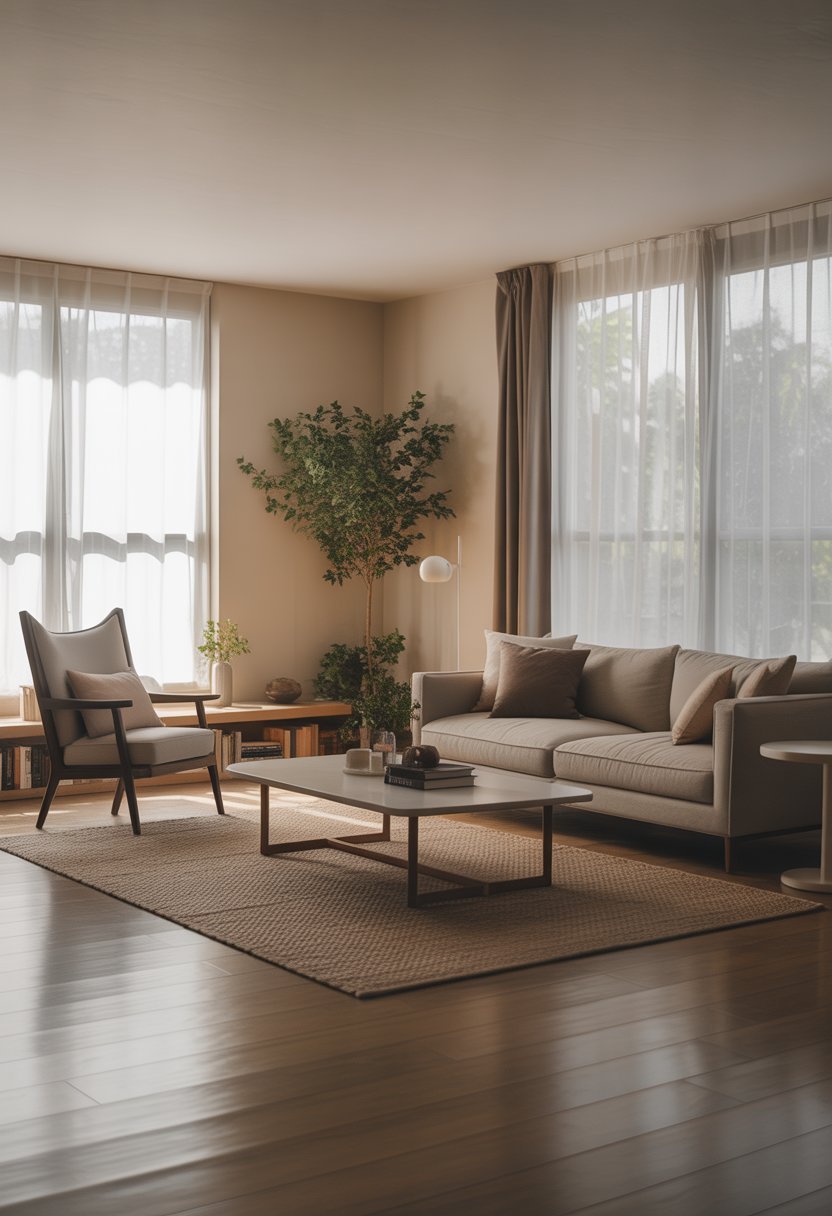
Filling empty space in a living room works best when you place furniture with intention. It’s about making the room feel balanced and useful.
Using floating sets, larger pieces, and extra seating can turn awkward areas into inviting spots. Sometimes it’s easier than you’d think.
Floating Furniture Arrangements
I like to pull furniture away from the walls to create floating arrangements. This way, you use the space in the middle of the room instead of leaving it empty.
A sofa, an accent chair, and a couple of ottomans grouped around a rug or coffee table give you a cozy, defined area. Floating furniture also improves flow and allows clear paths for walking.
This setup often works best in larger rooms. The key is to keep enough room around pieces so it doesn’t feel crowded but still feels connected.
Using Larger Scale Pieces for Impact
Big furniture can fill space quickly and make a statement. A large comfy chair or a wide sectional sofa can take up dead space and create a focal point.
Choosing pieces that fit the room’s scale avoids that sparse, empty feeling. Sometimes I go for floor cushions or poufs—they add volume but don’t overwhelm the view.
They’re handy for extra seating and easy to move around. One or two large items in the right spot add weight and interest, which keeps the room from feeling too bare.
Creating Functional Zones
Empty space can become a functional zone that serves a purpose beyond just sitting. Placing a small desk or console table in a corner can create a home office or reading nook.
This breaks up large open areas and gives focus to unused spots. If I want to divide a big room, I use furniture to make clear zones—maybe a bench to separate a lounge area from a dining or play space.
These zones should feel natural and not block movement. Rugs or lighting along with furniture can help define them visually.
Incorporating Additional Seating
Extra seating is key to filling space and boosting the room’s usability. I add accent chairs, stools, or poufs near the main seating.
These fill gaps and make the space more welcoming for guests. Ottomans are practical because they serve as seats, footrests, and even surfaces for trays or books.
Floor cushions create informal, flexible seating—great for a casual vibe. When I pick extra seats, I try to balance comfort with style and keep them easy to move for different occasions.
Decorative Ideas for Walls and Corners
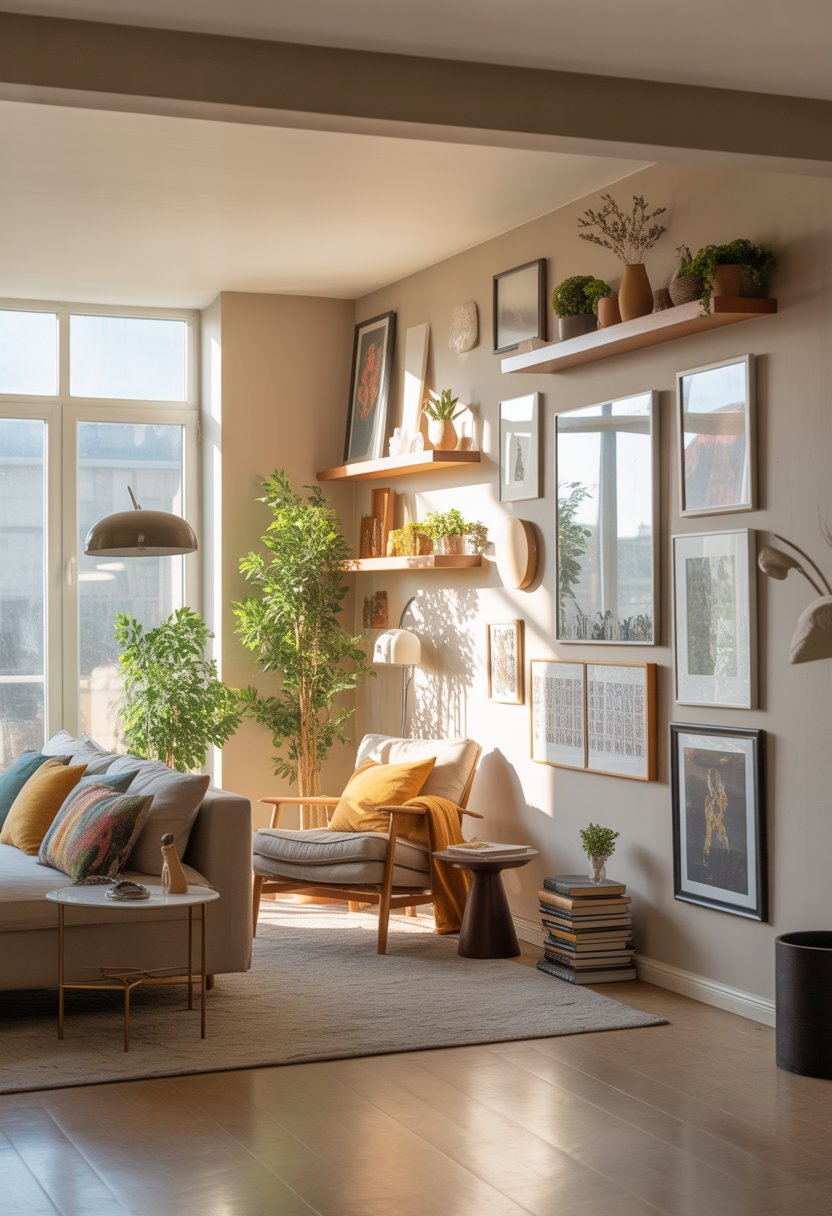
Empty walls and corners in a living room offer great chances to add style and function. Art, shelves, and mirrors can really improve your space.
Each option brings something different, so I just pick what fits the room’s size and my needs. Sometimes it’s a toss-up, honestly.
Gallery Walls and Artwork Displays
A gallery wall is a fun way to personalize an empty wall. I pick a mix of framed photos, prints, or paintings that show my style.
Arranging them carefully—balancing large pieces with smaller ones—makes a big difference. I keep the frames similar in color or style so the display feels cohesive.
This setup draws the eye and fills space without clutter. If I use a corner for art, a tall sculpture or hanging fabric piece works well.
Installing Bookshelves and Shelving
Shelves add storage and decoration to empty walls or corners. I like floating shelves because they don’t take up floor space and can hold books, plants, or small art objects.
Placing shelves vertically fills narrow corners effectively. For a bigger statement, floor-to-ceiling bookshelves work great in larger areas.
They turn an empty spot into a cozy reading nook or a display zone for collectibles. I arrange items in groups to keep things from looking crowded.
Statement Mirrors and Wall Accents
Mirrors can open up a room by reflecting light and adding depth. I pick a large mirror with an interesting frame to fill a blank wall or corner.
This makes the space brighter and feels bigger. Besides mirrors, wall accents like metal art, wood panels, or decorative plates add texture and interest.
Placing these accents side by side or above furniture helps finish off the corner decor without overwhelming the space.
Enhancing Spaces with Lighting and Plants
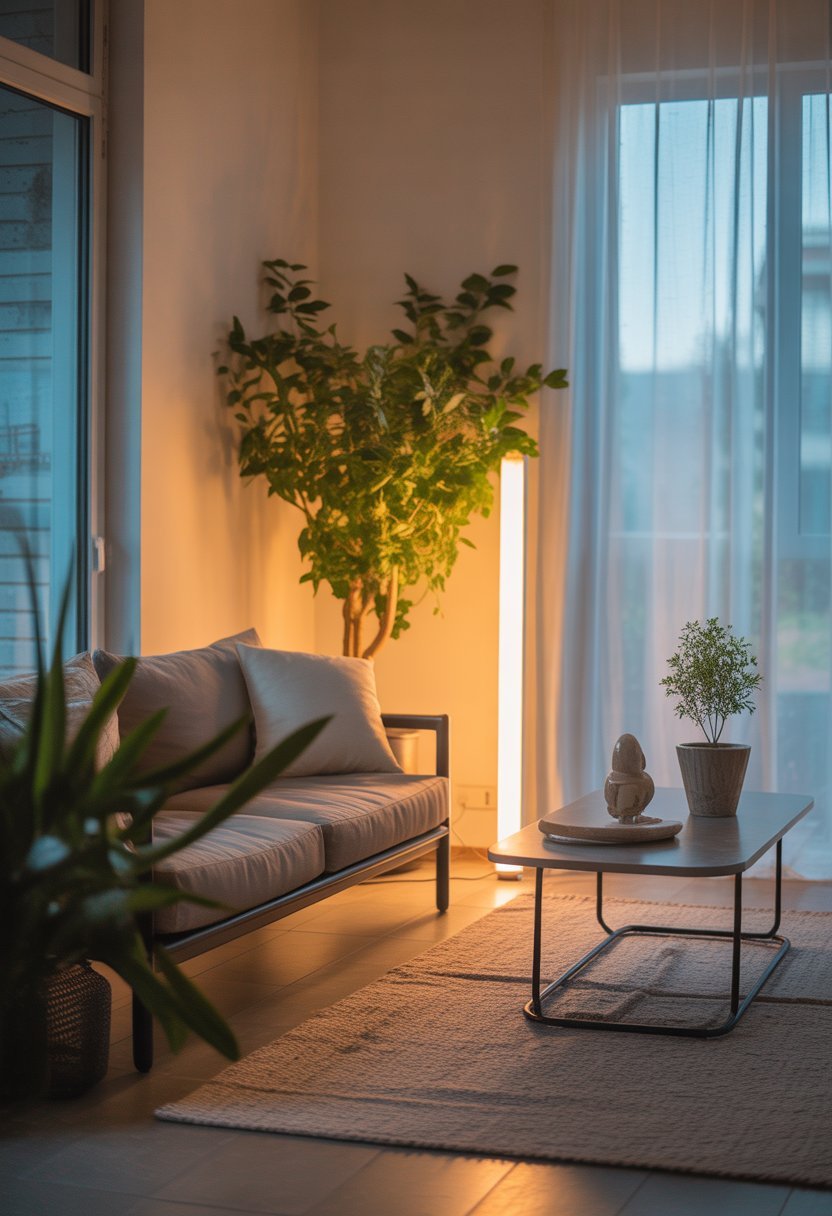
Adding lighting and plants can totally change the feel of empty spaces in a living room. Both bring life and warmth and help fill awkward corners without crowding things.
Mixing different types of lamps and a variety of indoor plants creates layers that make the room inviting and balanced.
Floor Lamps and Sconces
I often start with floor lamps because they add height and light without taking much space. A tall floor lamp works well in corners where furniture won’t fit.
It can brighten up dark spots and create a cozy reading nook. Lamps with adjustable heads let you direct light where you need it most.
Sconces are great for walls near empty spaces. They don’t use floor space and can soften harsh overhead lighting.
I like sconces with dimmers so I can change the mood easily. Placing them on either side of an empty corner or near wall art highlights the area without clutter.
Table Lamps for Ambiance
Table lamps offer a softer, more intimate light. I put them on small side tables or shelves near empty spaces.
Their warm glow can make a large room feel cozier. When picking table lamps, size matters—too big can overwhelm the corner, too small just gets lost.
Lamps with fabric shades usually diffuse light nicely. A set of matching table lamps on opposite sides of a room creates balance and draws the eye around your living space.
Tall Plants and Indoor Greenery
Tall plants are one of my favorite ways to fill empty corners. They add texture and height, filling vertical space naturally.
Plants like fiddle leaf figs or snake plants work well because they have a strong presence but aren’t fussy. I always consider lighting and room humidity before picking real plants.
If the space doesn’t get much natural light, a hardy plant or a good faux plant might be a better fit. Grouping smaller plants together can also fill space when a big plant feels like too much.
Hanging and Plant Stands
Hanging plants really help when you want greenery but don’t want to lose floor space. I like hanging them near windows or tucked into corners—there’s something about that upward look that adds depth and draws your eye up.
They also bring a fresh vibe right at eye level or higher, which just feels good.
Plant stands let me lift up smaller pots, so the room doesn’t feel so flat. I mix stands at different heights to keep things interesting.
When I combine these with hanging plants, I get a nice balance of greenery without making the space feel crowded.
For more lighting and plant ideas, check out this guide on how to fill empty space in your living room.
Functional and Cozy Accessories
Filling empty space isn’t just about stuffing in more things. I look for pieces that actually do something while making the room feel more inviting.
The right furniture and decor can balance comfort and practicality, so the living room ends up cozy but still useful.
Area Rugs and Coffee Tables
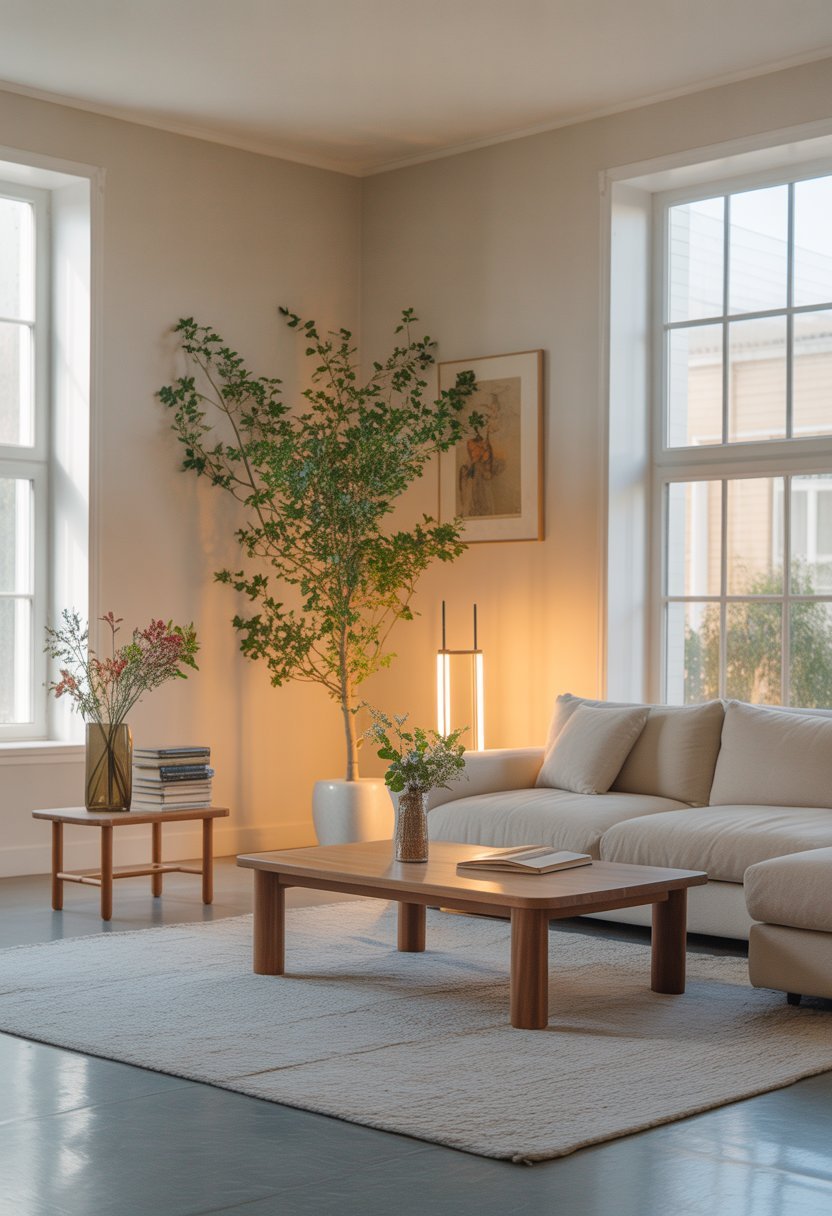
Area rugs really help define a space and make it warmer, especially in big rooms. I usually pick rugs that go with my furniture’s colors and textures, but I make sure they’re big enough so at least the front legs of the seating sit on them.
Coffee tables are one of those essentials—they give you a spot for drinks, books, or just a bit of decor. I lean toward round or oval tables since they soften the look and are safer if you’ve got kids running around.
Storage coffee tables are a win for keeping clutter out of sight. They add style and function, which I appreciate.
Console and Side Tables
Console tables fit nicely against empty walls or behind sofas. I use them for lamps, photos, or a couple of plants—enough to fill the space without making it feel stuffed.
If there’s already a big media console, I go for a narrow or lighter console table to keep things from feeling too heavy.
Side tables are perfect next to chairs or sofas for quick access to a lamp or your drink. I pick ones that either match or contrast with my coffee table, depending on my mood.
They don’t need to be huge—just enough space for the basics.
Throws, Decorative Pillows, and Blankets
Throw pillows are an easy way to add color, texture, and comfort. I like to mix sizes and shapes, but I try to keep the color palette somewhat consistent so things don’t get chaotic.
Simple patterns or solid colors usually look more put-together, at least in my experience.
Throw blankets help a room feel lived-in and warm. I’ll drape one over the back of the couch or fold it on an armchair.
Choosing throws with soft textures or subtle details makes the space cozy without feeling cluttered.
Storage Solutions and Woven Baskets
Extra storage keeps the room tidy and fills up empty corners. I’m a fan of woven baskets—they add natural texture and are handy for blankets, magazines, or toys.
Baskets come in all sorts of sizes and shapes, so it’s easy to tuck one into a corner or by a chair. Pairing a basket with a nearby console or seat gives a practical, organized vibe and softens up empty spots.
Creative and Multi-Purpose Solutions
You can turn empty living room spaces into useful, inviting areas. Why not create spots for hobbies, relaxing, or entertaining?
It makes the space feel fuller and, honestly, more you.
Music and Hobby Corners
When I have a bit of extra space, I’ll set up a small music corner. A compact piano, guitar stand, or some shelves for sheet music gives musicians a dedicated spot to play or practice.
It keeps gear organized and out of the main walkways, which I appreciate.
If music isn’t your thing, maybe try a craft or art station. A small desk with storage bins keeps supplies neat and close by, so you can create whenever the mood hits.
Add a comfy chair and good lighting, and you’ve got a personal retreat.
Play Area for Kids
Making a play area for kids is a smart way to use empty corners. I’ll usually add a soft rug, some toy storage, and a small table for drawing or puzzles.
This keeps toys in one spot and gives kids a safe zone that feels like part of the living room, not just an afterthought.
Clear bins or cubbies make cleanup fast and teach kids to stay organized. I try to put the play area near where I sit, so I can keep an eye on things while relaxing.
Good lighting and washable materials are a must for keeping the area kid-friendly and easy to clean.
Creating Cozy Nooks and Dividers
Even a small, unused corner can become a cozy reading or relaxation nook. I’ll add a plush chair or bench, a few cushions, and a small table for books or a drink.
A floor lamp is key—it gives enough light without being too harsh.
Room dividers or tall shelves help define these nooks and add privacy. Decorative screens or open shelving break up the space without making it feel closed off.
This kind of setup works well if you want to split your living room into zones for different activities. It’s practical and adds a little character, too.
Bar Carts and Entertaining Stations
If I want to boost my living room’s social energy, I’ll tuck a bar cart into an empty corner. It’s such a simple way to stash drinks, glasses, and those odd little cocktail tools, without cluttering up the main hangout zone.
The best bar carts have shelves and racks, and honestly, they look way better if they vibe with the rest of the room. I usually roll mine close to the dining or lounge spot, so grabbing a drink feels natural when friends are over.
Tossing on a crystal decanter or a set of wine glasses instantly makes the setup feel more welcoming. Plus, it’s way more practical, whether you’re hosting a party or just having a chill night in.
Want more ideas for those tricky empty spots? Check out this guide on how to fill empty spaces in the living room.
